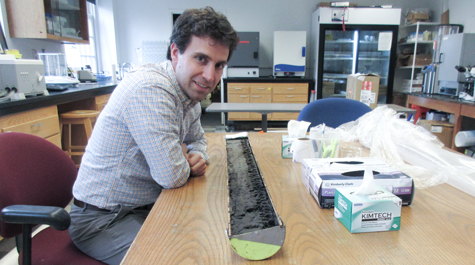A deep-ocean current shift gives 400-year notice of massive climate change
The warm waters of the Gulf Stream flow up along the east coast of North America, moderating the climate of vast areas of northern and western Europe.
Once the Gulf Stream gets far enough north, the warm waters cool. As they cool, they sink and start flowing south, forming what scientists call the North Atlantic Deep Water.
Nick Balascio explained that the Gulf Stream/Deep Water system is known as the AMOC, or Atlantic Meridional Overturning Circulation. Balascio, an assistant professor in William & Mary’s Department of Geology, is a member of a group of scientists that found evidence that changes in the strength of AMOC can serve as an precursor to massive future climate changes.
Their findings were published in the journal Nature Communications in a paper “Deep-water circulation changes lead North Atlantic climate during deglaciation.” Deglaciation, or the widespread melting of glaciers, have triggered massive shifts in climate. Balascio explains that the team’s evidence shows that a strengthening in the AMOC flow was a precursor to a sudden warming trend about 11,000 years ago.
Conversely, a weakening AMOC was followed by what is known as the Younger Dryas stadial, a major cooling period about 13,000 years ago. Balascio pointed out that each shift in AMOC strength preceded the climactic shift by the same amount of time — around 400 years.
He also noted that the AMOC has been weakening once again for the past century or so. The paper indicates that once the Younger Dryas settled in, air temperatures in Greenland dropped by about six degrees.
“These results suggest that changes in ocean circulation precede major global climate events,” he said. “So we should therefore take seriously the evidence that suggests the AMOC has been slowing down over the past century or more.”
The team recorded the relative strength of the AMOC and the development of the Deep Water Formation through comparison of various coring samples of ice and sediment from various points across the North Atlantic, including sites from the land, ocean and lakes.
“Each record provides one piece of the puzzle,” Balascio said. “So each record provides information on a different aspect of the climate system such as past atmospheric temperatures and surface ocean conditions.”
The team was led by Francesco Muschitiello, who is associated with the University of Cambridge and Columbia University’s Lamont-Doherty Earth Observatory. Other members of the team were from the Norwegian Research Centre & Bjerknes Centre for Climate Research, Oregon State University, the University of Sheffield and Purdue University.
Balascio’s contribution was to conduct tephra analysis, or examination of key volcanic ash layers to establish the chronology in the marine sediment record that generated much of the data for the study.
“In order to address questions about leads-and-lags of climate and ocean circulation, we had to establish how old sections of the core were with precision,” he said.
Balascio acknowledges that the ocean and climate conditions of today are quite different from the days when the Younger Dryas was getting a toehold on the world’s climate.
“But these results provide insight into the mechanisms for how the systems respond and interact,” he said. “If we use them, we can better model and predict future changes.”















